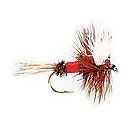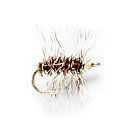By Joe Coklin
Presidential Range, brook trout often seem to appear out of nowhere to attack a muddler. Even trout as small as two or three inches have voraciously pounced upon my drifting muddler. Although other flies will catch trout in these frigid waters, nothing, in my experience, works nearly as well. My best guess as to why the muddler minnow is such a great fly to fish in high-elevation streams is because it looks and acts like possibly the trout’s only large prey item, the slimy sculpin. Muddler minnows are truly effective because they can not be fished wrong; they are perfect for the beginning fly fisher. Cast it upstream or down. Float it, sink it, swing it or twitch it. Wherever trout abound, particularly brook trout, a muddler tied to your tippet will usually produce results. It is the muddler’s versatility, which accounts for its deadly effectiveness. If I were restricted in my pursuit of wild brook trout to a single fly pattern, the muddler minnow would be my choice–hands down. If you do not include a few muddlers in sizes 6-10 in your small stream fly box, the trout will thank you!
2. Woolly Bugger:

3. Griffith’s Gnat:
Chironomids. Trout consume prodigious quantities of these tiny insects and in some environments they represent the only food upon which a trout may depend. Chironomids, commonly called “midges”, are most available to trout in ponds and beaver impoundments; however, most New Hampshire trout streams, with the possible exception of high-gradient mountain streams, follow a serpentine course along at least part of their length. These “s” bends often contain ideal habitat for midges due to slower flows and sediment deposition. The griffith’s gnat is a simple dry fly which imitates either individual adults or clusters of them. I often add an antron tail as a trailing shuck in hopes of depicting the difficult transition between the pupal and adult stages of development. As is common with most effective fly patterns, the griffith’s gnat is easy to tie. It consists of a peacock herl body with a grizzly hackle palmered throughout. One should tie these in sizes 14-22.
4. Royal Wulff:

5. Pheasant Tail Nymph:
Frank Sawyer was a river keeper on the famed chalk streams of southeast England. He was also a keen observer of nature and an innovative fly tyer. The pheasant tail nymph is his creation. The trout of England’s chalk streams grow fat and fast on a rich soup of macro invertebrates. After countless hours watching the interactions of the trout and its prey, Frank devised a fly that mimicked the general profile of the various insects that comprised his trout’s daily diet. He also tied his pheasant tail nymph with brass wire instead of thread. This allowed him to maintain the slim profile of the diminutive insects he was trying to imitate and also sink the nymph quickly to the level of the feeding trout. Today’s version of the pheasant tail nymph usually includes peacock herl for the thorax and perhaps a bead head; otherwise it is very similar to Frank’s original design. My fly box contains pheasant tail nymphs from sizes 14 down to 20.
Joe Conklin is a member Trout Unlimited, a guide and a renowned speaker. Reach him at -mail: flydudeme@yahoo.com
[easy-social-share]

